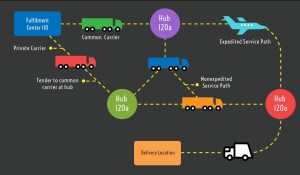Can Amazon read our minds?

Amazon is working on a new technology that, based on data analysis, will allow them to predict purchases before they even happen and send the items to destination.
Shipping it before you even want it!
Amazon.com, the Seattle-based ecommerce giant, has always leveraged data. In one of their latest business moves, the company has filed a patent for a shipping system designed to cut delivery times by predicting what buyers are going to buy before they buy it. This system will allow Amazon to ship products to potential customers’ direction, or even right to their door, before the sales click even happens.
The patent was filled in August 2012 and granted on December 2013, for a method Amazon calls “anticipatory shipping” which is described as follows:
“…a method may include packaging one or more items as a package for eventual shipment to a delivery address, selecting a destination geographical area to which to ship the package, shipping the package to the destination geographical area without completely specifying the delivery address at the time of the shipment, and while the package is in transit, completely specifying the delivery address for the package.”
How would it work?
The anticipated location of packages might be determined by analyzing various “business variables”, according to the patent. Amazon has an enormous amount of user data that could be analyzed to determine customer demand for a particular pre-shipped package to help decide where to route it geographically. This data could include historical buying patterns, preferences expressed explicitly via surveys/questionnaires, demographic data, browsing habits, wish-lists and so on.
Probably, this predictive model will be used first on high turnover products on which frequencies of purchase allows data analysis to predict consumption and where a mistake during the “machine learning” process would not imply a loss for the e-commerce giant.
It is important to notice the difference between predicting when an item is going to be purchased and predicting when a specific person is going to make a purchase; and then, is even more difficult, to predict what exactly he or she will buy. To achieve this, Amazon will need a huge amount of data on consumers to figure out the time and the product they need. As what the mental model is concern, they will probably use explanatory variables related to the global behavior of the users as well as specific behavior seen on them and their social networks (ex. if close friends buy a product that is trendy in my region, chances are I’ll get it too).
How does it create value? who benefits from it?
This system looks to generate speed by lowering the response time for Amazon’s consumers, from the generation of the need for an item until they have received it in their homes. By doing this, the company can find new cost efficient ways to ship products and customers can get their purchases sooner. The automatic ordering could also be a time saving feature for busy clients won’t have to spend time on the platform to order every time they need a high turnover item.
An interesting view on the value this could create for Amazon is from the perspective of entry barriers and competitive advantage. By this response time improvement, amazon captures future value from their current and future customers, since they create a big entry barrier to potential competitors (Ex. Jet) that will struggle to sell to customers that already got what they needed in their homes right before needing it (thus, amazon might increase its market share).
This technology well managed and marketed could help increases customer service perception for Amazon, although it could also be frightening if not managed well enough (customers could feel stalked or invaded in their privacy). If successful, increased sales should overcome increased costs of return for small “prediction” mistakes and therefore improve the experience for customers and financials for the company.
Very little is known about the current progress on this idea or how Amazon pretends to monetize it. An option could be capturing the value through a subscription model like their “Amazon Prime” feature or offering an “instant” shipping option for a fee.
What we can tell for sure, is that Amazon, as other companies, sees in data analytics great opportunities that will allow them to thrive even more in this new e-commerce that is just beginning.




I agree that there are definitely PR risks, but if this becomes a reality and is rolled out well, it would be an amazing feat of both data and operational ability. I wonder what amount of data is required to do something like this, and particularly within individual customers how many purchases they would need to make before Amazon is able to start predicting?
Wow, this is a really cool concept. I think you’re right to point out that there is a big difference between predicting when an item is going to be purchased and predicting when a specific person will make a purchase and when. But even if they can predict that someone in Cambridge, MA will buy this product, ship it to the nearest warehouse, and show that there is 1 day or same day delivery to all customers in that area, it could really create an convenience advantage. It would certainly cut into the value proposition for apps like Favor and Google Express, which I think some people use for products they could get on Amazon but after 2 days.